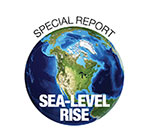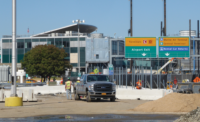 After Superstorm Sandy hit in 2012, science and news organization Climate Central identified the top 12 U.S. airports vulnerable to storm-surge flooding accelerated by sea-level rise.
After Superstorm Sandy hit in 2012, science and news organization Climate Central identified the top 12 U.S. airports vulnerable to storm-surge flooding accelerated by sea-level rise.
Two of the 12 airports, San Francisco and Oakland, are at the forefront of addressing the issue. Rinaldi Wibowo, SFO project manager, says the airport’s eight miles of shoreline is protected by earth berms, sheet-pile walls and concrete walls, installed over the past 30 years. “We have two locations with no protection: outside the airfield at the wastewater treatment plant and a U.S. Coast Guard air station. Those have no walls. Those are the gaps,” observes Wibowo.
In 2015, SFO determined that, by midcentury, a 100-year flood will require protection of six feet. The port is considering raising its levee, restoring the shallow bay lands and installing more levees, among other options, he says.
Other airports have assessed their vulnerabilities, too.
“There have been lots of studies,” says Chris Oswald, vice president of safety and regulatory affairs for Airports Council International-North America. “It’s not a new issue, but a huge amount of attention was paid after Sandy hit.”
AIRPORTS Twelve of the nation’s largest airports have at least one runway with an elevation within 12 ft of current sea levels.
Josh DeFloria, chief of resilience and sustainability for the Port Authority of New York & New Jersey says dozens of new projects will begin over the next two to five years to meet FEMA’s new 100-year-event standards. Currently, LaGuardia’s new, under-construction central terminal is designed for the 100-year elevation plus 40 in., he notes.
“And you can’t just raise one runway – you would have to raise the entire airport.”
– Carol Lurie, VHB
Miami International Airport anticipates 2 ft of sea rise by 2060; in 2014, the county mandated that all future projects consider it, says Pedro Hernandez, assistant director of facilities development. Now under construction is a 60,000-sq-ft baggage-handling building, which includes that 2-ft floor elevation, he says. “You have to consider the life of the asset,” he says. “For example, pavement systems are only there 14 or 15 years. So, you only have to consider minimal rise.”
Calculating and addressing sea-level rise is not simple, cautions Carol Lurie, principal with VHB. “You also have continental uplift. An area may be rising and keeping pace with the sea-level rise, or it may be sinking. Also, as the sea level rises, so may the groundwater. Anything in the ground has to be retrofitted. And you can’t just raise one runway—you would have to raise the entire airport.”





Post a comment to this article
Report Abusive Comment